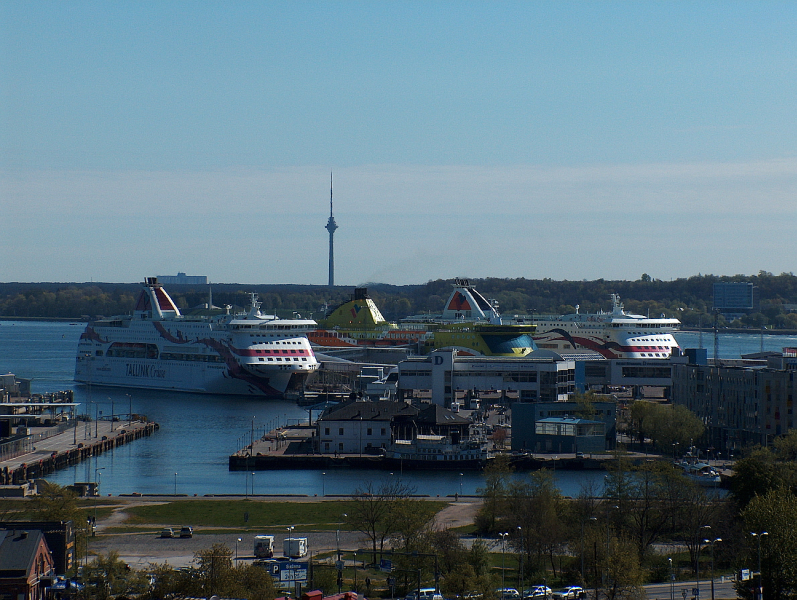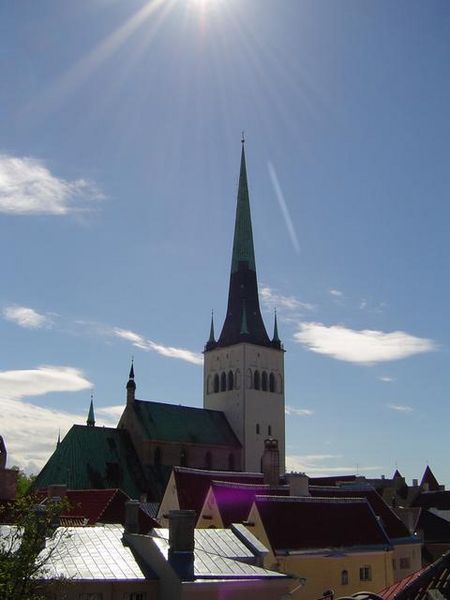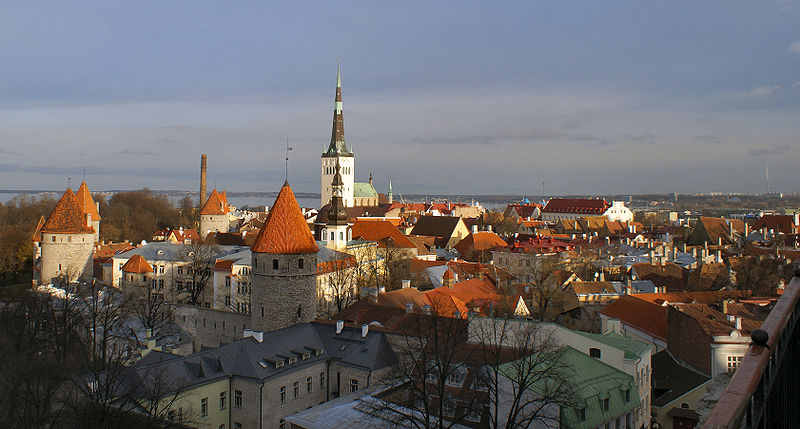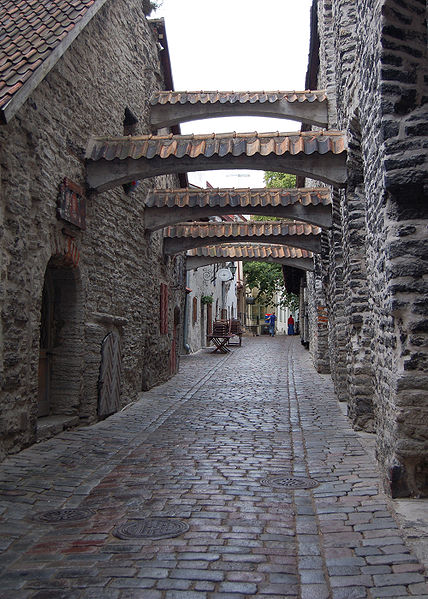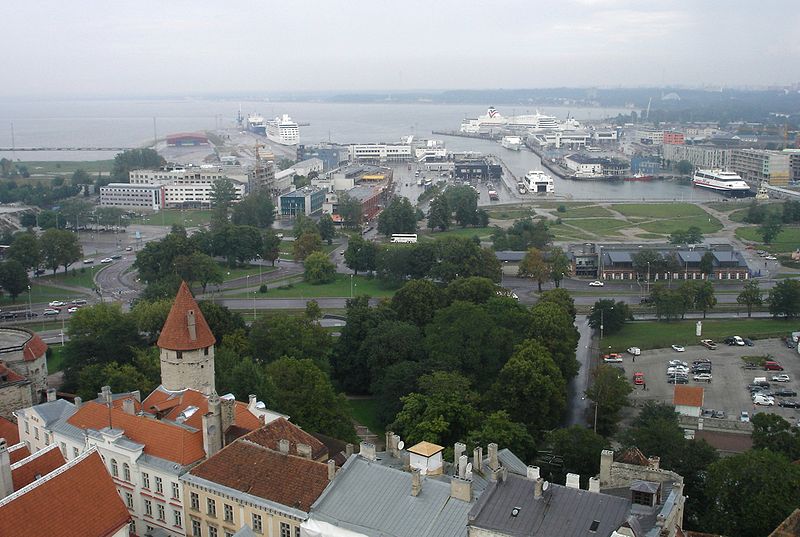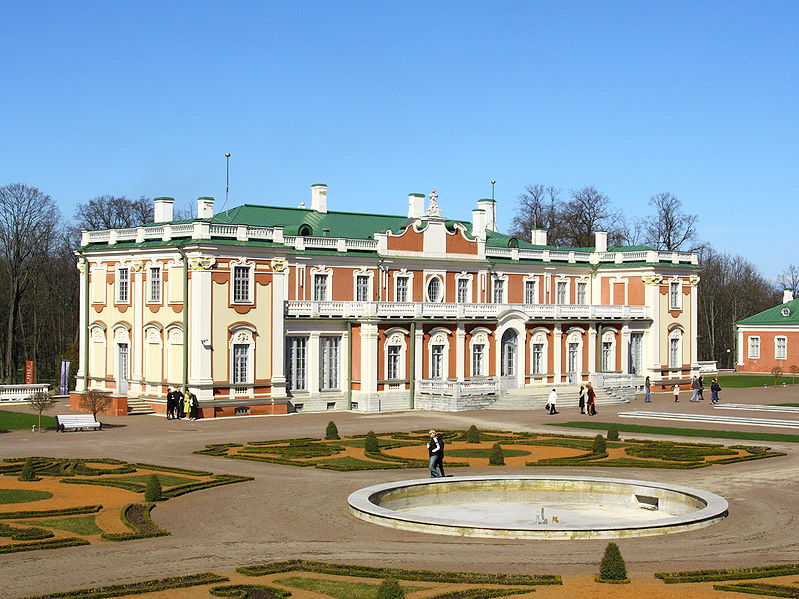<Back to Index>
- Harju, Estonia Tallinn, 415K
PAGE SPONSOR
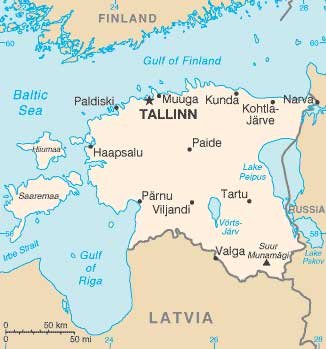
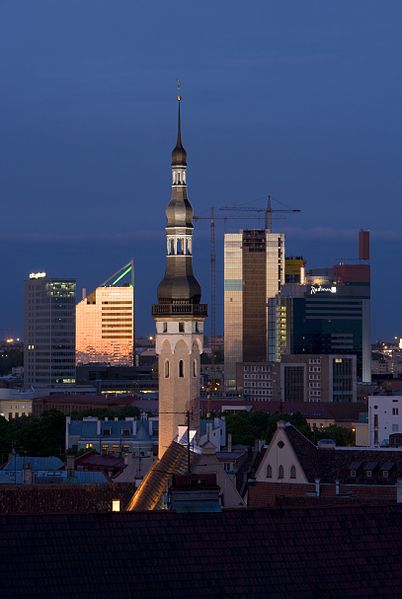
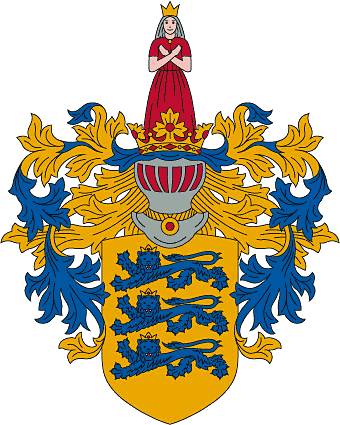
Tallinn is the capital and largest city of Estonia. It occupies an area of 159.2 km2 (61.5 sq mi) with a population of 414,940. It is situated on the northern coast of the country, on the banks of the Gulf of Finland, 80 km (50 mi) south of Helsinki, east of Stockholm and west of Saint Petersburg. Tallinn's Old Town is in the list of UNESCO World Heritage Sites. It is ranked as a global city and has been listed among the top 10 digital cities in the world. The city is a European Capital of Culture for 2011, along with Turku, Finland.
In 1154 a town called Qlwn or Qalaven (possible derivations of Kalevan or Kolyvan) was put on the world map of the Almoravid by cartographer Muhammad al-Idrisi who described it as a small town like a large castle among the towns of Astlanda. It has been suggested that the Quwri in Astlanda may have denoted the predecessor town of today's Tallinn.
The earliest names of Tallinn include Kolyvan (Russian: Колывань) known from East Slavic chronicles, the name possibly deriving from the Estonian mythical hero Kalev.
Up to the 13th century the Scandinavians and Henry of Livonia in his chronicle called the town Lindanisa: Lyndanisse in Danish, Lindanäs in Swedish, also mentioned as Ledenets in Old East Slavic. According to some theories the name derived from mythical Linda, the wife of Kalev and the mother of Kalevipoeg, who in an Estonian legend carried rocks to her husband's grave that formed the Toompea hill.
It has been also suggested that in the context the meaning of linda in the archaic Estonian language, that is similar to lidna in Votic, had the same meaning as linna or linn later on meaning a castle or town in English. According to the suggestion nisa would have had the same meaning as niemi (meaning peninsula in English) in an old Finnish form of the name Kesoniemi.
Other than Kesoniemi known ancient historical names of Tallinn in Finnish include Rääveli. The Icelandic Njálssaga mentions Tallinn and calls it Rafala, which is a variant of the name Raphael.
After the Danish conquest in 1219 the town became known in the German, Swedish and Danish languages as Reval (Latin: Revalia). The name originated from (Latin) Revelia (Estonian) Revala or Rävala, the adjacent ancient name of the surrounding Estonian county.
The origin of the name "Tallinn(a)" is certain to be Estonian, although the original meaning of the name is debated. It is usually thought to be derived from "Taani - linn(a)" (meaning "Danish - castle / town"; Latin: Castrum Danorum) after the Danes built the castle in place of the Estonian stronghold at Lindanisse. However, it could also have come from "tali - linna" ("winter - castle / town"), or "talu - linna" ("house / farmstead - castle / town"). The element -linna, like Germanic -burg and Slavic -grad / -gorod, originally meant "fortress" but is used as a suffix in the formation of town names.
The previously used official German name Reval (Ревель) was replaced after Estonia became independent in 1918 – 1920. At first both forms Tallinna and Tallinn were used. The United States Board on Geographic Names adopted the form Tallinn between June 1923 and June 1927. The form Tallinna appearing in modern times in Estonian denotes the genitive case of the name, as in Tallinna Reisisadam (Port of Tallinn).
Other variations of modern spellings include Tallinna in Finnish and Та́ллин in Russian.
A form Tallin deriving from the Romanization of Russian spelling of the name Та́ллин was also used internationally during the era Estonia was annexed to the Soviet Union.
The first traces of human settlement found in Tallinn's city center by archeologists are about 5000 years old. The comb ceramic pottery found on the site dates to about 3000 BC and corded ware pottery c. 2500 BC.
In 1050 the first fortress was built on Tallinn Toompea.
As an important port for trade between Russia and Scandinavia, it became a target for the expansion of the Teutonic Knights and the Kingdom of Denmark during the period of Northern Crusades in the beginning of the 13th century when Christianity was forcibly imposed on the local population. Danish rule of Tallinn and Northern Estonia started in 1219.
In 1285 the city became the northernmost member of the Hanseatic League – a mercantile and military alliance of German dominated cities in Northern Europe. The Danes sold Tallinn along with their other land possessions in northern Estonia to the Teutonic Knights in 1346. Medieval Tallinn enjoyed a strategic position at the crossroads of trade between Western and Northern Europe and Russia. The city, with a population of 8,000, was very well fortified with city walls and 66 defense towers.
A weather vane, the figure of an old warrior called Old Thomas, was put on top of the spire of the Tallinn's Town Hall in 1530 that became the symbol for the city.
With the start of the Protestant Reformation the German influence became even stronger as the city was converted to Lutheranism. In 1561 Tallinn politically became a dominion of Sweden.
During the Great Northern War, Tallinn along with Swedish Estonia and Livonia capitulated to Imperial Russia in 1710, but the local self government institutions (Magistracy of Reval and Chivalry of Estonia) retained their cultural and economical autonomy within Imperial Russia as the Duchy of Estonia. The Magistracy of Reval was abolished in 1889. The 19th century brought industrialization of the city and the port kept its importance. During the last decades of the century Russification measures became stronger.
On 24 February 1918, the Independence Manifesto was proclaimed in Tallinn, followed by Imperial German occupation and a war of independence with Russia. On 2 February 1920, the Tartu Peace Treaty was signed with Soviet Russia, wherein Russia acknowledged the independence of the Estonian Republic. Tallinn became the capital of an independent Estonia. After World War II started, Estonia was occupied by the Soviet Union (USSR) in 1940, and later occupied by Nazi Germany from 1941 to 44. After the Nazi retreat in 1944, it was again occupied by the USSR. After annexation into the Soviet Union, Tallinn became the capital of the Estonian SSR.
During the 1980 Summer Olympics, the sailing (then known as yachting) events
were held at Pirita, north - east of central Tallinn. Many buildings,
such as the "Olümpia" hotel, the new Main Post Office building, and
the Regatta Center, were built for the Olympics.
In August 1991 an independent democratic Estonian state was re-established and a period of quick development to a modern European capital ensued. Tallinn became the capital of a de facto independent country once again on August 20, 1991.
Tallinn has historically consisted of three parts:
- The Toompea (Domberg) or "Cathedral Hill", which was the seat of the central authority: first the Danish captains, then the komturs of the Teutonic Order, and Swedish and Russian governors. It was until 1877 a separate town (Dom zu Reval), the residence of the aristocracy; it is today the seat of the Estonian government and many embassies and residencies.
- The Old Town, which is the old Hanseatic town, the "city of the citizens", was not administratively united with Cathedral Hill until the late 19th century. It was the center of the medieval trade on which it grew prosperous.
- The Estonian town forms a crescent to the south of the Old Town, where the Estonians came to settle. It was not until the mid 19th century that ethnic Estonians replaced the local Baltic Germans as the majority amongst the residents of Tallinn.
Historically, the city has been attacked, sacked, razed and pillaged on numerous occasions. Although extensively bombed by Soviet air forces during the latter stages of World War II, much of the medieval Old Town still retains its charm. The Tallinn Old Town (including Toompea) became a UNESCO World Cultural Heritage site in 1997.
At the end of the 15th century a new 159 m (521.65 ft) high Gothic spire was built for St. Olaf's Church. Between 1549 and 1625 it was the tallest church in the world. After several fires and following rebuilding, its overall height is now 123 m (403.54 ft).
Tallinn is situated on the southern coast of the Gulf of Finland, in north - western Estonia.
The largest lake in Tallinn is Lake Ülemiste (covering 9.6 km²). It is the main source of the city's drinking water. Lake Harku is the second largest lake within the borders of Tallinn and its area is 1.6 km². Tallinn does not lie on a major river. The only significant river in Tallinn is Pirita River in Pirita, a city district counted as a suburb. Historically, the small Härjapea River flowed from Lake Ülemiste through the town into the sea, but the river was diverted for sewage in the 1930s and has since completely disappeared from the cityscape.
A limestone cliff runs through the city. It can be seen at Toompea, Lasnamäe and Astangu. However, Toompea is not a part of the cliff, but a separate hill.
The highest point in Tallinn, at 64 meters above sea level, is situated in Hiiu, Nõmme District, in the south - west of the city.
The length of the coastline is 46 kilometers. It comprises three bigger peninsulas: Kopli peninsula, Paljassaare peninsula and Kakumäe peninsula.
For local government purposes, Tallinn is subdivided into 8 administrative districts (Estonian: linnaosad, singularlinnaosa). The district governments are city institutions that fulfill, in the territory of their district, the functions assigned to them by Tallinn legislation and statutes.
Each district government is managed by an Elder (Estonian: linnaosavanem). He or she is appointed by the City Government on the nomination of the Mayor and
after having heard the opinion of the Administrative Councils. The
function of the Administrative Councils is to recommend, to the City
Government and Commissions of the City Council, how the districts should
be administered.
The registered population of Tallinn is 414,940 (as of 1 Nov 2011).
According to Eurostat, in 2004 Tallinn had the largest number of non - EU nationals of all EU member states' capital cities. As of 2009 around 22% of its population are not EU citizens.
In addition to the native Estonian language (which is of the Finnic group,
closely related to the Finnish language), English, Finnish and Russian
are widely understood in Tallinn. Russian is also widely spoken as a
native language.
In addition to longtime functions as seaport and capital city, Tallinn has seen development of an information technology sector; in its 13 December 2005, edition, The New York Times characterized Estonia as "a sort of Silicon Valley on the Baltic Sea". One of Tallinn's sister cities is the Silicon Valley town of Los Gatos, California. Skype is one of the best known of several Estonian start-ups originating from Tallinn. Many start-ups started from the Soviet - era Institute of Cybernetics. The economic sectors of Tallinn also include the light, textile, and food industry, as well as the service and government sector. There is a small fleet of ocean going trawlers that operate out of Tallinn. Port of Tallinn is one of the biggest ports in the Baltic sea region.
Currently, over half of the Estonian GDP is created in Tallinn. In 2008, the GDP per capita of Tallinn stood at 172% of the Estonian average. This makes the GDP of Tallinn be at 115% of the European Union average, while the overall GDP level of Estonia is at 67% of the EU average.
Among others: NATO Cooperative Cyber Defence Centre of Excellence (CCDCOE); Estonian Air has its headquarters in Tallinn. Skype has its software development center located in Tallinn; Ericsson has one of its biggest production facilities in Europe located in Tallinn, focusing on the producing of 4G communication devices. Statoil has announced moving the group's financial center to Tallinn. Institutions of higher education and science include: Tallinn University, Tallinn University of Technology, Estonian Business School, Estonian Academy of Music and Theatre, Estonian Academy of Arts, Public Service Academy, Estonian Evangelical Lutheran Church Institute of Theology.
Since its return to independence, improving air and sea transport links with Western Europe and Estonia's accession to the European Union have made Tallinn easily accessible to tourists.
Estonia has made rapid economic progress since independence and this is reflected in local prices. Although not extortionate, neither are prices as cheap as in other former Eastern Bloc countries.
The main attractions are in the two old towns (Lower Town and Toompea) which are both easily explored on foot. Eastern districts around Pirita and Kadriorg are also worth visiting and the Estonian Open Air Museum (Eesti Vabaõhumuuseum) in Rocca al Mare, west of the city, preserves aspects of Estonian rural culture and architecture.
The city operates a system of bus (62 lines), tram (4 lines) and trolley - bus (8
lines) routes to all districts. A flat fare system is used. Payment for
single tickets is made either by pre-purchase of tickets at street side
kiosks or by a purchase from the transport vehicle. Monthly cards are
available by registering through the national ID-card.
The Lennart Meri Tallinn Airport is about four kilometers from Town Hall square (Raekoja plats). There is a local bus connection between the airport and the edge of the city center (bus no. 2). The nearest railway station Ülemiste is only 1.5 km from the airport. The construction of the new section of the airport began in 2007 and was finished in summer 2008.
There has been a helicopter service to and from Helsinki operated by Copterline and taking 18 minutes to cross the Gulf of Finland. The Copterline Tallinn terminal is located adjacent to Linnahall, five minutes from the city center. After a crash near Tallinn in August 2005, service was suspended but restarted in 2008 with a new fleet. The operator cancelled it again in December 2008, on grounds of unprofitability. On 15 February 2010, Copterline filed for bankruptcy, citing inability to keep the company profitable.
The Edelaraudtee railway company operates train services from Tallinn to Tartu, Valga, Türi, Viljandi, Tapa, Narva, Orava, and Pärnu. Buses are also available to all these and various other destinations in Estonia, as well as to Saint Petersburg in Russia and Riga in Latvia. The Go Rail company operates a daily international sleeper train service between Tallinn - Moscow.
Tallinn also has a commuter rail service running from Tallinn's main rail station in two main directions: east (Aegviidu) and to several western destinations (Pääsküla, Keila, Riisipere, Paldiski, Klooga and Kloogaranna). These are electrified lines and are used by the Elektriraudtee railroad company. The trains are a mixture of modernized older Soviet EMU's and newly built units. The first electrified train service in Tallinn was opened in 1924 from Tallinn to Pääsküla, a distance of 11.2 kilometres.
The Rail Baltica project, which will link Tallinn with Warsaw via Latvia and Lithuania, will connect Tallinn with the rest of the European rail network. A tunnel has been proposed between Tallinn and Helsinki, though it remains at a planning phase.
The Via Baltica motorway (part of European route E67 from Helsinki to Prague) connects Tallinn to the Lithuanian / Polish border through Latvia.
Frequent and affordable long distance bus routes connect Tallinn with other parts of Estonia.
